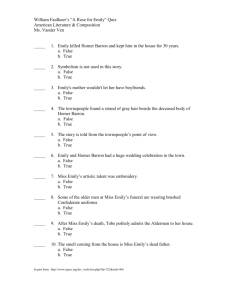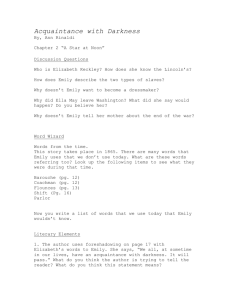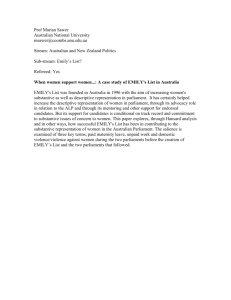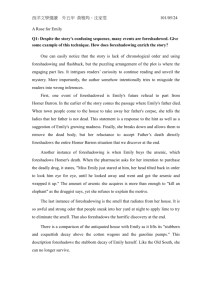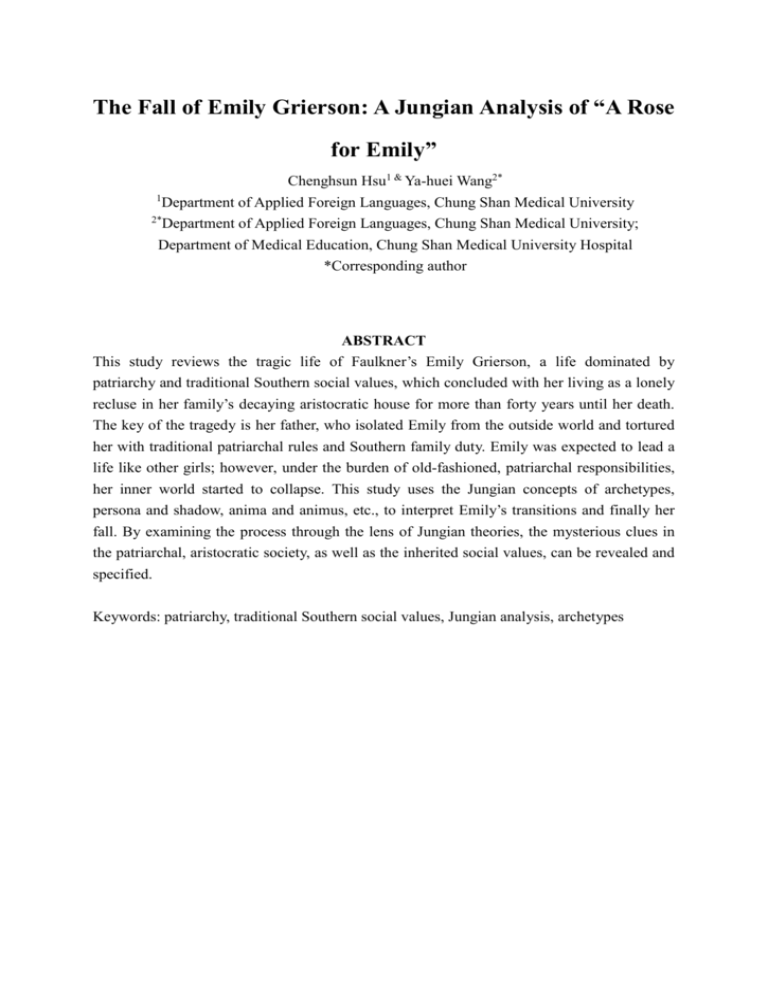
The Fall of Emily Grierson: A Jungian Analysis of “A Rose
for Emily”
Chenghsun Hsu1 & Ya-huei Wang2*
1
Department of Applied Foreign Languages, Chung Shan Medical University
2*
Department of Applied Foreign Languages, Chung Shan Medical University;
Department of Medical Education, Chung Shan Medical University Hospital
*Corresponding author
ABSTRACT
This study reviews the tragic life of Faulkner’s Emily Grierson, a life dominated by
patriarchy and traditional Southern social values, which concluded with her living as a lonely
recluse in her family’s decaying aristocratic house for more than forty years until her death.
The key of the tragedy is her father, who isolated Emily from the outside world and tortured
her with traditional patriarchal rules and Southern family duty. Emily was expected to lead a
life like other girls; however, under the burden of old-fashioned, patriarchal responsibilities,
her inner world started to collapse. This study uses the Jungian concepts of archetypes,
persona and shadow, anima and animus, etc., to interpret Emily’s transitions and finally her
fall. By examining the process through the lens of Jungian theories, the mysterious clues in
the patriarchal, aristocratic society, as well as the inherited social values, can be revealed and
specified.
Keywords: patriarchy, traditional Southern social values, Jungian analysis, archetypes
INTRODUCTION
William Faulkner, the author of the short story “A Rose for Emily”, was born in the state of
Mississippi. The state’s history and culture inspired him and is reflected in several of his
literary works, such as The Sound and the Fury and As I Lay Dying. He is a representative
American writer and Nobel Prize laureate. Given that the revolution occurred in the late 18th
century and the decline of the Southern economy in the late 1860s, by creating the character
of Emily Grierson, a southern woman tortured by the traditional patriarchy of her
environment and forbidden love (which eventually results in her mental disorder), Faulkner
expresses his pity and love for his birthplace, as well as a nostalgia for the past. Faulkner was
born more than three decades after the end of slavery, which was abolished after the Civil
War. On September 22, 1862, Abraham Lincoln, the sixteenth President of the United States,
issued the Emancipation Proclamation, which went into force in January 1863, abolishing
slavery and freeing slaves who did not already live in freedom in the North (Masur, 2012).
The abolishment of slavery also disrupted the landowner-oriented economy. Being born in a
wealthy family, Faulkner witnessed the continued decline of Southern aristocracies and the
tragic position of Black and White Americans, which inspired his series of works set in his
invented locale of Yoknapatawpha County.
Most of Faulkner’s novels and short stories deal with the vicissitudes of the society of
the American South, the falling of aristocracies, and nostalgia for the Old South. Emily
Grierson and the townspeople are traditional American Southerners clinging to the South’s
earlier glory. They are resistant to change, and hence are stuck in the collective
unconsciousness of the memorable glory of Southern aristocrats, the Old South that would
never be back.
COLLECTIVE UNCONSCIOUS
Coined by Jung, collective unconscious is a term used in analytic psychology, representing
part of the unconscious mind. Based on Jung (1968), the collective unconscious is the deepest
layer of the psyche, beneath the personal unconscious and ego/consciousness. The collective
unconscious is related to the unus mundus, an underlying unified psychophysical reality that
everything emerges from and finally returns to, a realm of archetypal forms common to all
human beings (Casement, 2001; Christopher & Solomon, 1999). Since the collective
unconscious is associated with cultural and social factors and can be expressed through
archetypal images as commonly accepted symbols, myths, or truths of any particular time or
period, it can be used to interpret an individual’s initiation and socialization into the gender
role expected of him or her in the development of identity (Christopher & Solomon, 1999).
The collective unconscious can be formed immutably through immersion in certain cultures
and social values; therefore the same collective unconscious is shared by all those human
beings who share the same cultural and social values (Christopher & Solomon, 1999). In
other words, the culturally bounded collective unconscious is shared by those with similar
experiences, opinions, and values. As Robinson (2010) said, if human beings live in the same
culture, they may share similar experiences, behavior patterns, and social values. These
experiences, behaviors, and social values are known as the collective cultural unconscious or
cultural archetypes (see Figure 1).
There are some perceived qualities in each collective cultural unconscious or cultural
archetype which can be used to evaluate and assess a certain group of people with the same
collective memory by what that society or community has experienced. The history of the
history of the antebellum South—the world of aristocratic honor, wealthy plantation owners
and slavery—remained rooted in the collective memories of Southern communities long after
the Civil War (Du, 2007).” Therefore, in the story of “A Rose for Emily,” when Emily
Grierson, a symbol of the Old South, passes away, the whole town attends her funeral, “the
men through a sort of respectful affection for a fallen monument” (29). As Du (2007) said,
she is the symbol of a past age for the townspeople, and her death signifies the final
separation from the past.
Culture
Society
Figure 1. The relationship of collective unconscious, personal unconscious, and
ego/consciousness under the influence of culture and society, adapted from Christopher and
Solomon’ model
ARCHETYPES
The contents of the collective unconscious are called archetypes. Jung (1968) defined
archetypes as primordial patterns of behaviors which can be copied or emulated by all human
beings. As Casement (2001) said, archetypes are an inherent part of the psyche, giving rise to
patterned tendencies of thoughts and behaviors. The values and viewpoints of human beings
are potentially influenced by archetypes that represent different time periods of identification
and memory (Matthews, 2002). Based on Jung, archetypes are passive reflections of higher
levels of being, be it the creator or the unconscious. However, they become active when they
are applied to the phenomenal, sensory, or conscious worlds, as a reflection of the spiritual
world—that is, the unus mundus, as Jung (1968) called it. Through the interaction of
archetypal images, there come archetypal paradigms of universal symbols, myths, and motifs,
such as the shadow, the anima/animus, the great mother, etc. (Jung, 1968; Matthews, 2002;
Neumann, 1955).
PERSONA AND SHADOW
“Persona” is a word derived from Latin, originally referring to the theatrical masks worn by
actors in ancient Greece and Rome in theatrical performances to signify the roles they played
(Palmer, 2003). Jung defined the persona as the social face an individual presented to the
world, allowing him or her to make a positive impression on others while concealing his or
her true nature (Jung, 1971). The persona can be revealed in dreams in the disguise of a
variety of forms. According to Jung (1989), all human beings wear masks, having certain
personas through which to negotiate with the outer world for survival. It could be said that
the persona is a human’s publicly displayed appearance, linking that person with the social
world (Zhu & Han, 2013). Nonetheless, the constant wearing of a mask may have a negative
impact on a human being. If the persona becomes too dominant over one’s natural personality,
this imbalance generates neurosis. As Palmer (2003) said, when individuals become
dominated by the persona they hide behind, using a public image to flexibly adapt to the
outer world, they may suffer from delusions or an inferiority complex, resulting in an
inability to relate to others and to accept the complementary sides of themselves.
Moreover, when human beings are accustomed to wearing psychological masks, it
becomes impossible for them to discover, live with and appreciate their real selves. They may
find it difficult to remove the mask and live in reality (Jung, 1971). When wearing a mask
becomes a habit, an individual may lose sight of his or her true self, thus causing an identity
crisis.
In contrast to the persona, the shadow refers to inferior traits, animalistic instincts, or the
unconscious part of the personality that individuals do not want to reveal to others (Jung,
1938). It is always suppressed or controlled, but can be released under great stress. The less
the shadow embodied in individuals’ consciousness, the more dangerous the shadow is.
ANIMA AND ANIMUS
Opposed to the dangerous functions of the shadow archetype, Jung (1977) described the
anima and the animus as two archetypes meditating between the ego and the inner life. Both
refer to the domain of the unconscious transcending the personal psyche. As Christopher and
Solomon (1999) said, the anima is the feminine image in a man’s psyche, while the animus is
the masculine image in a woman’s psyche. Every individual may have psychological features
of the opposite sex, one being consciously expressed and one being hidden unconsciously, in
order to maintain equilibrium and understanding between men and women (Zhu & Han,
2013). Those men who only show their masculine features and hide their feminine traits in
unconsciousness become unconsciously fragile and sensitive, while those women who only
show their feminine features and repress their masculine traits become unconsciously strong
and stubborn. Hence, it may be said that human beings with an imbalanced anima or animus
threaten their mental health.
As mentioned above, persona and shadow coexist. In “A Rose for Emily,” Mr. Grierson,
Emily’s father and the support of the Grierson family, tries to live in hereditary aristocratic
honor, although the family’s circumstances have deteriorated since the Civil War. When her
father is alive, he chases off every suitor that comes near her, denying Emily the choice of
taking up the traditional role of wife and mother and isolating her from the other townspeople.
She is frustrated in every attempt at courtship until she meets Homer Barron, a man who pays
attention to her but is ultimately unwilling to marry her. Once she realizes that Homer has no
intention of marrying her, she loses her sanity.
Moreover, without a mother image, Emily has to turn to her father’s image for identity
development, resulting in her animus becoming chaotic and ambivalent, torn between living
up to her family's heritage of aristocratic honor and the desire to be a loving (and beloved)
wife and mother. Since human beings are eager to be socially connected and to associate with
others to keep a sound mind and further strengthen their personal identities, for Emily,
everything a girl should have, such as love, friendship, etc., is stripped away by her father.
Her father expels all her suitors: “None of the young men were quite good enough for Miss
Emily and such” (p. 32). Having been isolated from the outside world by her father, Emily is
not able to fit into the life of the town, but retreats to her archaic aristocratic honor for
survival and identification. Mr. Grierson’s looming presence, a symbol of that honor, is
everywhere in the house, in the “crayon portrait” on “a tarnished gilt easel before a fireplace”
(p. 30).
The animus also influences what kind of man a woman falls for. Emily’s beloved,
Homer, must have shared the same features as her animus: “a Yankee—a big, dark, ready
man, with a big voice and eyes lighter than his face”; boys would “follow in groups to hear
him cuss the niggers”; he was a man who “would be in the center of group” (p. 33). As the
townspeople said, at first,
we were glad that Miss Emily would have an interest, because the ladies all said, "Of
course a Grierson would not think seriously of a Northerner, a day laborer." But there
were still others, older people, who said that even grief could not cause a real lady to
forget noblesse oblige--without calling it noblesse oblige (p. 33).
Though the townspeople pity Emily for her love for Homer, it cannot be denied that
there are significant differences in their social class and origins. Although Emily family’s
circumstances have deteriorated since the Civil War, her family was once wealthy and she
still has family in Alabama who would not approve of her marrying Homer. For the
townspeople, Homer is an unlikely match for Emily. Therefore, the ladies and old people
begin to gossip about him as well as Emily, saying that, “Poor Emily. Her kinsfolk should
come to her” (p. 33).
PATRIARCHAL AND NOBLE ARCHETYPES
The definition of patriarchy changes depending on the cultural context in which it is
discussed; however, there is an agreement that patriarchy always functions through men
exerting control over those (particularly women and younger people) around them (John,
2005). With the power to control others, including women and other men subordinated to
them, they assume superior and privileged positions in society. In order to control others, men
are supposed to be strong, rational, knowledgeable, invulnerable, independent, and
unemotional. These masculine, patriarchal qualities are not expected in women, who are
expected to tender, fragile, emotional, voiceless, and submissive. Once men fail to maintain
these masculine qualities, they lose confidence and dignity in front of women and others.
“Control” becomes the means to bring order out of chaos, to protect men who are threatened
by competition and who want to prove their manliness in order to gain respect. Consequently,
the inevitable outcome of patriarchy is the oppression of women (Johnson, 2005). Women
who demonstrate patriarchal characteristics are at best criticized and at worst severely
punished by others in the patriarchal society.
According to the Bible, Eve was the sinner who caused human beings to be driven out of
the Garden of Eden; therefore, women were condemned as the origin of all evils. This
concept underpinned the control persecution of women in the American South—they were
forced to be submissive to men and the patriarchal system (Du, 2007). Moreover, in a
patriarchal society, the father has the absolute right to decide family affairs. Emily becomes a
victim of patriarchal and aristocratic dominance. Even after her father’s death, she cannot
escape this domination. The narrator describes Emily’s relationship with her father in the
following terms: “We had long thought of them as a tableau, Miss Emily a slender figure in
white in the background, her father a spraddled silhouette in the foreground, his back to her
and clutching a horsewhip, the two of them framed by the backflung front door” (p. 32). The
horsewhip represents the dominant power of a patriarch over his daughter, fragile and small,
retreating into the background. Emily is an object, controlled by her father, who carries a
horsewhip.
Women are taught to regard men as stronger, more ambitious, more rational, and the
dominant gender; they often look for ways to make up for what they lack in their
personalities and characters (Coward, 1992). Because of Emily’s upbringing in a patriarchal
Southern community, her animus prompts her to emulate the most intense masculine
characteristics. For in a conventional patriarchal system in the American south, men held
absolute power over their families. Emily, though born in a noble and well-esteemed family,
is nonetheless constrained by the pernicious moral codes of the patriarchy system in order to
make peace with the system (Du, 2007). Her father’s death, which overwhelms her with grief
to the extent that she will not allow the townspeople to bury him, releases her from the
patriarchal prison. However, the presence of the patriarchal father image in “the parlour” (p.
30) forces her to submit to the dominant system, “as if that quality of her father which had
thwarted her woman’s life so many times had been too virulent and too furious to die” (p.
34).
Being an aristocratic woman, she is constantly aware of, and reminds the townspeople of
her aristocratic heritage: a woman with “noblesse oblige” (p. 33), while at the same time, she
is irritated by the burden of patriarchy and aristocracy. After her father’s death, Emily cuts
her hair short, “making her look like a girl, with a vague resemblance to those angels in
colored church windows—sort of tragic and serene” (p. 32). It was the fashion for women to
keep their hair long but bound up close to the head until the early twentieth century, but for
Emily, long hair symbolizes the patriarchal chain that has oppressed her all her life. Her
short-cut hair signifies her determination to escape patriarchal oppression, although in a “sort
of tragic and serene” way (p. 32). However, the burden of the scar and inherited burden
caused by the patriarchy and her aristocratic heritage remained a negative influence on her
animus.
As a woman perceived by the older people in the town as having “noblesse oblige”
(p.33), she is destined to be watched, especially when she begins dating a Yankee. The
townspeople criticize their relationship: “Of course a Grierson would not think seriously of a
Northerner, a day laborer,” (p. 33) and older people say that “even grief could not cause a real
lady to forget noblesse oblige” (33). People begin to whisper and gossip about the love affair,
regarding it as a scandal.
As soon as the old people said “Poor Emily,” the whispering began. “Do you suppose it's
really so?” they said to one another. “Of course it is. What else could…” This behind
their hands; rustling of craned silk and satin behind jalousies closed upon the sun of
Sunday afternoon as the thin, swift clopclop-clop of the matched team passed: “Poor
Emily” (p. 33).
Despite the decay of the Grierson family, the older townspeople feel that being from a
higher social class, Emily should fulfill her duty to her family.
DISTORTED IDENTITY UNDER THE PATRIARCHAL SYSTEM
If an individual sticks to his/her publicly displayed appearance or social too much, the
persona becomes “inflated” (Zhu & Han, 2013). When the townspeople criticize Emily and
the Griersons, thinking that “the Griersons held themselves a little too high for what they
really were. None of the young men were quite good enough for Miss Emily and such” (p.
32). Even when she is dating Homer, a northern laborer, “she carried her head high
enough—even when we believed that she was fallen. It was as if she demanded more than
ever the recognition of her dignity as the last Grierson; as if it had wanted that touch of
earthiness to reaffirm her imperviousness” (p. 33).
Women always create certain conditions to secretly satisfy their desires (Coward, 1993).
Despite the rumors and gossip and her duty to her family, Emily spares no expense in buying
him the things that a man of her own class would have: she goes “to the jeweler’s and ordered
a man’s toilet set in silver, with the letters H.B. on each piece. Two days later we learned that
she had bought a complete outfit of men’s clothing, including a nightshirt” (p. 34). Having
fallen in love with Homer, she is determined to marry him. Emily experiences the feeling of
being in love when they are together “on Sunday afternoons driving in the yellow-wheeled
buggy” (p. 34).
Being from a once wealthy family, in order to satisfy the townspeople’s expectations,
Emily worked very hard to put on the mask/persona to meet the social norms and standards
formed by the community’s patriarchal and aristocratic values. She always aware of, and
reminds the townspeople of her aristocratic heritage: a woman with “noblesse oblige” (p. 33),
while at the same time, she is irritated by the burden of patriarchy and aristocracy. Her
cousins come to talk her out of marrying Homer, but fail to do. When she dates with Homer
or shopping, she is watched by the townspeople. The ladies and old people criticize their
relationship: “Of course a Grierson would not think seriously of a Northerner, a day laborer,”
(p. 33) and older people say that “even grief could not cause a real lady to forget noblesse
oblige.” (p. 33).
Zhu and Han (2013) mention that in order to live up to what was traditionally expected
of them, men often suppress their female aspect, and women their male characteristics. Hence,
the persona may occupy and constrain the anima/animus. Also, the contradiction between
persona and anima/animus may cause the anima/animus to overpower the persona, hence
making the individual go to the other extreme.
When her father is alive, she is totally dominated by him; he prevents her from marrying
during his lifetime, as the townspeople said that “None of the young men were quite good
enough for Miss Emily and such” (p. 32). After her father’s death, while falling in love with
Homer Barron, their riding out in public is regarded as a disgrace to her relatives and
southerners, as the townspeople said that “a disgrace to the town and a bad example to the
young people (p. 34). She insists on marrying Homer to escape from her destined patriarchal
womanhood. She steps out, preparing to totally surrender to the invasion of northern
industrialization, symbolized by Homer. After discovering that Homer has no intention of
marrying her, “because Homer himself had remarked—he liked men, and it was known that
he drank with the younger men in the Elks’ Club—that he was not a marrying man” (p. 34),
Emily is totally out of control and becomes insane.
She finally has a psychological breakdown. Afraid that she is going to lose Homer and
have to retreat to traditional Southern values, she decides to poison him in order to control
him. She cuts off connections with the outside world, sleeping next to his dead body and
living lonely and desperately until her death forty years later. She tears off her persona/mask
and lets herself be possessed by her inner masculine personality, breaking the balance
between her ego and her inner life. As mentioned, women of her time were taught to be
warm-hearted, submissive, and understanding. Supposedly, Emily was expected to take
advantage of feminine characteristics to manipulate Homer into marriage: she “will persuade
him yet” (p. 34). Bold emotions such as ambition, irritation, and domination should definitely
be avoided and controlled.
Overly possessed by her animus, Emily’s personality is transformed; she gives into the
prominent masculine characteristics that should supposedly belong to the opposite sex. Her
animus fails to mediate between her ego and her inner life. Possessed, Emily begins to lose
her sense of her own value and charms, determining to abandon the norms of her family (here
the ego), and attempting to build a bridge to the unconscious masculine aspect of her female
psyche. Possessed to too great a degree by her animus, Emily goes to extremes and becomes
paranoid; her animus keeps telling her that a man should be strong, independent, and resolute.
Women are expected to be sweet and submissive; therefore, in order to live up to social
expectations, they are used to putting on obedient and submissive personas. Overly possessed
by the unconscious masculine aspect of her female psyche, Emily is ultimately the victim of
the conflict between her persona and her animus. In the meantime, Emily’s anima loses its
ability to mediate between the ego and the inner life, and her personality is devoured.
Unable to believe that what she has done to her beloved is all in vain and lost in rage,
Emily decides to use her masculine qualities to brutally take revenge upon Homer. Emily
says to the druggist, “I want some poison,” with “cold, haughty black eyes in a face the flesh
of which was strained across the temples and about the eye sockets as you imagine a
lighthouse keeper’s face ought to look” (p. 33). She speaks resolutely to the druggist: “I want
the best you have. I don’t care what kind”; “I want arsenic” (p. 33). While the druggist is
looking down at her, she looks “back at him,” “stared at him, her head tilted back in order to
look him eye for eye, until he looked away and went and got the arsenic and wrapped it up”
(p. 33). She schemes to poison her beloved as she would a rat, in order to be with him
forever.
THE FALL OF A TRAGIC ARISTOCRATIC WOMAN UNDER PATRIARCHY
The expectations of the patriarchal system and the townspeople require Emily to follow their
laws and customs, to conform to the behavior patterns of the whole collective persona. She is
trained to be a lady to fulfill the “noblesse oblige” (p. 33) of the Griersons. When she is
betrayed by Homer, she loses her so-called “pure love,” which is her only hope of living a
fulfilled life after her father dies. Unfortunately, the pure love is turned into a contorted love,
causing Emily’s tragic change from a lady into a devil, killing Homer and keeping him with
her for forty years until her death.
Then we noticed that in the second pillow was the indentation of a head. One of us lifted
something from it, and leaning forward, that faint and invisible dust dry and acrid in the
nostrils, we saw a long strand of iron-gray hair (p. 36)
Although she is the last survivor of an aristocratic Southern family, being a woman,
Emily cannot escape from the rigorous traditional principles of the patriarchy, but is regarded
as a monument in memory of the social norms and standards formed by traditions and
society—as the townspeople said, “alive, Miss Emily had been a tradition, a duty, and a care;
a sort of hereditary obligation upon the town” (p. 40). When Emily passes away, the whole
town attends her funeral, “the men through a sort of respectful affection for a fallen
monument” (p. 29); she represents the past, the old patriarchal, aristocratic society that
existed before the Civil War.
Torn between the demands of patriarchal, aristocratic social values and what she really
wants, Emily never has a chance to control her fate and her own life, finally falling victim to
her own repressed desires.
REFERENCES
Casement, A. (2001). Carl Gustav Jung. London: Sage Publications.
Christopher, E. & Solomon, H. M. (1999). Jungian thought in the modern world. New York:
Free Association Books.
Coward, R. (1992). Our treacherous hearts: Why women let men get their way. London:
Faber and Faber.
Du, F. (2007). Who Makes a Devil out of a Fair Lady—An Analysis of the Social Causes of
Emily's Tragedy in A Rose for Emily. Canadian Social Science 3(4): 18-24.
Faulkner, W. (1930). A rose for Emily. In X. J. Kennedy and D. Gioia, (Eds.), An Introduction
to Fiction (pp. 29-36). Hong Kong: Pearson Longman Press.
Johnson, A. G. (2005). The gender knot: Unraveling our patriarchal legacy. Philadelphia, PA:
Temple University Press.
Jung, C.G. (1938). Collected works of C. G. Jung: Psychology and religion: West and east. (R.
F. C. Hull Trans.). Princeton, N.J.: Princeton University Press.
Jung, C. G. (1968). Collected works of C. G. Jung: The archetypes and the collective
unconscious. (R. F. C. Hull Trans.). London: Routledge.
Jung, C.G. (1971). Collected works of C. G. Jung: Psychological Types, The collected works
of C.G. Jung. (R. F. C. Hull Trans.). Princeton, N.J.: Princeton University Press.
Jung, C.G. (1977). Collected works of C. G. Jung: The relations between the ego and the
unconscious. (R. F. C. Hull Trans.). Princeton, N.J.: Princeton University Press.
Jung, C. G. (1989). Memories, dreams, reflections. (A. Jaffe, Ed., R. & C. Winston, Trans.).
New York: Vintage Books.
Masur, L. P. (2012). Lincoln's hundred days: The emancipation proclamation and the war for
the union. Cambridge: MA: Harvard University Press.
Matthews, R. (2002), Competition archetypes and creative imagination. Journal of Change
Management 15(5): 461-476.
Neumann, E. (1955). The great mother: An analysis of the archetype. London: Routledge &
Kegan Paul.
Palmer, M. (2003). Freud and Jung on religion. New York: Routledge Taylor & Francis
Group.
Robinson, C. (2010). Harnessing cultural archetypes: Rediscovering the collective cultural
unconscious and the stuff Americans are made of. Journal of Quality and
Participation 32(4): 15-20.
Zhu, J., & Han, L. (2013). Analysis on the Personality of Maggie by Jung's archetype theory.
Theory and Practice in Language Studies 3(2): 324-328.

